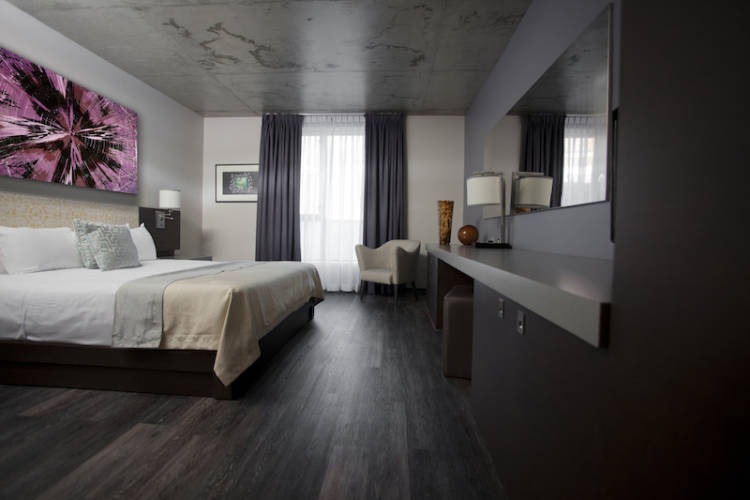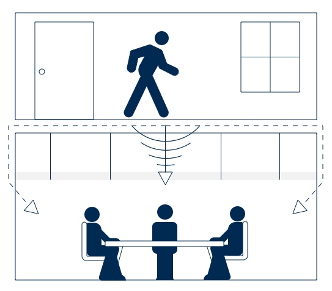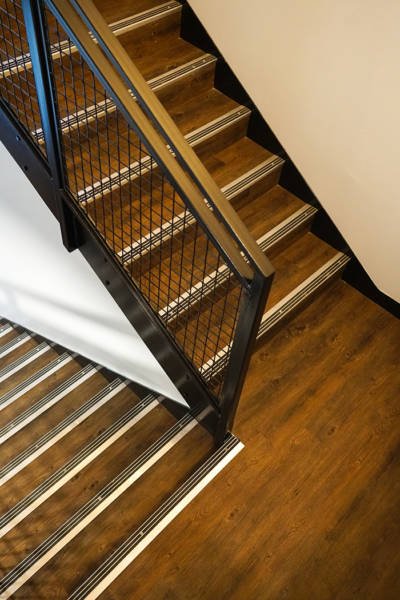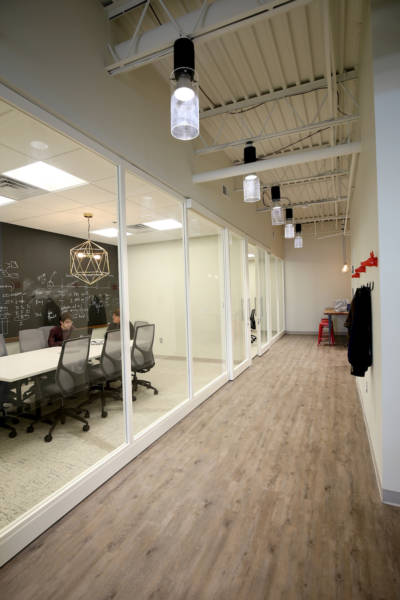Flooring Acoustics & LVT for Noise Reduction

When we think about interior design, we often think of the visuals — the color scheme, the décor, and the layout of the space. However, one vital, but often forgotten element that also plays a very important role in design is sound.
Flooring choice impacts not only the look of a room or building, it also determines how noisy or quiet the space will be. In commercial settings such as hospitals, retail stores and multifamily buildings, having quiet flooring is a top priority. Luckily, there are many options on the market today that are made specially to balance beautiful design with noise reduction. This is known as acoustic flooring.
Acoustic Flooring & Sound
In the simplest of terms, sound is transmitted by waves that travel through the air and received through electrical signals to the brain. In commercial settings, these “waves” are created by a number of events, objects and people. It might be a rolling cart in a grocery store, a person working out in a fitness studio, or just a noisy tenant in a multifamily apartment building — all of these environments require a sound-absorbing solution.

A great way to lessen the impact of these sound producers is with acoustic flooring solutions. This flooring is specially designed to reduce noise, and comes in many types, sizes and colors. Two of the most popular choices for acoustic flooring are LVT and hardwood flooring. These versatile flooring options have countless design options and have natural sound absorbing properties. But how do you measure a flooring’s ability to muffle noise?
Acoustic Flooring Tests
There are two acoustics tests that are widely uses across industries, including flooring, to gauge how well a material or product will muffle or absorb sound.
1. Impact Insulation Class (IIC): The Impact Insulation Class (IIC) is a method of rating the impact sound transmission performance of an assembly. The higher the IIC, the better the impact noise control of the element. An IIC of 55 is generally considered a good impact noise control. For reference, Parterre’s loose lay LVT has an IIC of 64 and the rigid core click flooring has a score of 68.
- Delta IIC – this is a follow-up to the IIC test, and it measures the improvement of sound reduction from the first IIC test to the second
2. Sound Transmission Class (STC): The Sound Transmission Class (STC) method of rating airborne sounds evaluates the comfort ability of a particular living space. The higher the STC, the better the airborne noise control performance of the structure. An STC of 50 or above is generally considered a good airborne noise control rating.
LVT and hardwood flooring have traditionally performed well on these tests, making it an optimal choice for flooring installations in high-traffic, busy locations. However, if the flooring you’re interested in isn’t super sound absorbing, there are additional steps you can take.
Using LVT or Hardwood for Acoustic Flooring
If you choose LVT or hardwood for your next acoustic flooring option, there are few things to keep in mind. Here is a quick guide to utilizing these materials in your next soundproofing project.
1. Types of LVT: There are multiple types of LVT — glue down, floating, and rigid core click are the most common — but two are renowned for their acoustic properties:
- Rigid Core Click: Rigid core click is an easy to install LVT option that can be simply clicked and locked into place. The benefit of rigid core is its specialized backing that reduces sound from heavy foot traffic or other elements rolling over the floor with attached cushion.
- Loose Lay: Loose Lay LVT typically comes in 5mm thickness, which makes it naturally more sound absorbing. However, loose lay makes it easy to apply a non-skid back, which adds another layer of padding and makes loose lay another great acoustic flooring choice.
2. Types of Hardwood: Hardwood flooring is quite versatile when it comes to acoustic properties. Softer hardwoods, such as pine, spruce, and cedar, are all excellent choices for sound absorption. When installed over a proper subfloor or acoustic subfloor, hardwood’s sound reducing qualities greatly increase.
It’s also important to note the differences between solid hardwood and engineered hardwood planks. Solid hardwood, as it sounds, are solid planks of hardwood harvested from a single board. Engineered hardwood, on the other hand, is a very thin layer of hardwood board over a plywood or MDF subfloor. This gives the appearance of traditional solid hardwood flooring without the full cost.
3. Benefits of Soundproofing: Soundproof flooring, or at least acoustic flooring, is ideal for most commercial settings. However, two settings in particular most often call for sound absorbing flooring installations.
-
- Multi-family housing – In multifamily housing buildings or complexes, acoustic flooring is the optimal choice. Installing sound absorbing flooring is a no-brainer in living areas, but it should also be considered for common areas, lobbies and fitness facilities if appropriate.
- Hospitality – Hotels and motels definitely require acoustic flooring. The last thing you want to encounter are disgruntled guests who have been disturbed by unnecessary noise during their stays. Furthermore, if the hotel or motel is located in a city or near busy roadways, these flooring options will be even more critical to ensure happy guests.

LVT Noise Reduction Options:
LVT, depending on what type you use, can be a great acoustic flooring
solution. If you’re looking for extra floor soundproofing, there are a couple tools you can use to enhance a floor’s performance.
1. Acoustic Underlayment: Typically made of foam or recycled fiber materials, acoustic underlayment can be installed over subflooring, but below LVT planks and tiles. With underlayment, LVT flooring will get added cushioning and enhanced sound absorbing properties.
2. Sound Absorbing Floor Insulation: This is ideal for pre-existing installs or for installations that will include new subflooring. Sound absorbing floor insulation goes below the subfloor beneath the floor joists and is another excellent acoustic flooring option.

These are both excellent options, but there are some flooring options — namely, LVT — that don’t require any extra padding or foam to be noise reducing. In fact, many LVT options come with an attached IXPE backing that enhances its noise reducing properties. With or without IXPE backing, LVT is a popular choice for acoustic flooring.
Paterre’s Rigid Core Click with specialized acoustic backing, loose lay and dryback LVT options can be enhanced with sound absorbing materials, and are suited for versatile installations. LVT is a great acoustic flooring option, which is just one of the many reasons it’s so popular in nearly any commercial setting.
Sandra Drake
Vice President of Sales
With over 20 years of commercial LVT experience, Sandra has worked in Business Development for the Healthcare, Government and Education Segments of a large flooring manufacturer. Moving into a role as Senior Director of commercial LVT product development and sourcing, working directly for the SVP of Commercial Hardsurface. Sandra also has worked with companies to develop new LVT product lines and unique patterns with designers.
Sandra is certified with Speak Easy and Dale Carnegie and a member of IIDA, ASHE/AHA, RFCI, and NEWH.
Polished Concrete vs. Vinyl Flooring
Polished Concrete vs. Vinyl Flooring Polished concrete vs. vinyl flooring. It’s not an easy decision, considering both provide an excellent solution for commercial flooring. The look of concrete floors has been a growing trend for commercial interiors.
Chevron and Herringbone
Break the Pattern of Commercial Flooring You can add more flair to your commercial flooring by breaking from the look of traditional straight-line, square, and diagonal patterns. Eye-catching looks like chevron and herringbone will dot the designer landscape in 2024.